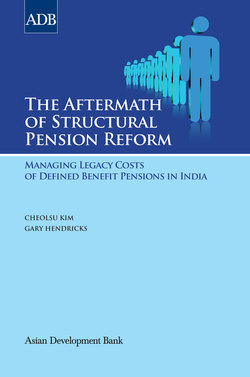Читать книгу The Aftermath of Structural Pension Reform - Cheolsu Kim - Страница 7
На сайте Литреса книга снята с продажи.
ACKNOWLEDGMENTS
ОглавлениеThis book records the efforts carried out from 2006 to 2011 to establish a pension and payroll database system for five states in India: Assam, Bihar, Chhattisgarh, Jharkhand, and Madhya Pradesh. The databases were then used to project each state’s pension liabilities and explore options to manage such liabilities. These efforts were supported by a technical assistance project financed by the Japan Special Fund of the Asian Development Bank (ADB). The assistance was headed by Cheolsu Kim (project leader), principal financial sector specialist, ADB, and Gary Hendricks (task manager), a veteran regulator and pension analyst with over 35 years of experience.
The transition from a conventional paper-based to an automated payroll recording system was a huge undertaking. The mind-set of people accustomed to traditional practices had to be changed. Political commitment from each state government—to adopt the proposed reforms and to adapt to these— needed to be secured. Each state’s efforts had to be guided through the arduous task of manually inputting data on up to 300,000 employees and 150,000 pensioners. Technical advice and oversight had to be provided during the formulation and implementation of automated procedures capable of continuously updating data once automated. Throughout these efforts, the project benefited from the strong commitment and generous effort of many institutions and individual stakeholders, which we acknowledge and for which we express our appreciation and gratitude.
First, we wish to acknowledge the Government of India for its active participation and support for the project. In particular, we would like to express our gratitude to K. P. Krishnan, secretary, Economic Advisory Council to the Prime Minister; Tarun Bajaj, joint secretary (pension and insurance), Department of Financial Services; Shashank Saksena, director, Department of Financial Services, Ministry of Finance; and Anuradha Thakur, director, Department of Economic Affairs, Ministry of Finance. Discussions with and comments from them were very useful and provided many insights, which have been used in the implementation of the project and in the writing of this book.
The five states played a pivotal role in the installation of automated employee, payroll, and pensioner databases, with ADB providing the project design and required inspiration and guidance, as well as technical and occasional hands-on assistance. Each state provided the human resources, supervision, and financing (sometimes with donor assistance) necessary to construct the databases, execute the automation designs, update computer hardware and software, and implement new processing procedures. Deep gratitude is therefore offered to the state secretaries of finance, without whose foresight, commitment, and leadership none of the states could have succeeded in installing the data systems. Also crucial were the participation and support of the directors of treasuries and accounts in each state and major district treasuries. They were the primary instruments of project implementation by supervising the many dozens (usually hundreds) of state civil servants who provided the source data and were trained on and executed the new methods of operation. Indebtedness is also owed to the State Bank of India, which provided high-quality, fully automated data on pensioners whose pensions it administers. In some states, it administers upward of 90% of all state pensions. The effort to install automated payroll and pensioner databases in the five states could not have succeeded without its assistance.
We would like to acknowledge the consultants who worked so tirelessly to complete this project. Subhash Garg, an Indian Administrative Service officer who was on sabbatical and, later, partial leave, acted as co-team leader for the 4 years required to construct the databases. Two international information technology experts, Ashish Joshi and Sanjay Sangal, worked assiduously in the field, providing critical technical assistance to the states.
Finally, we also wish to acknowledge Bruno Carrasco, director, South Asia Department, for his support and invaluable advice. Anna Alipio, associate project officer, and Pamela Gutierrez, associate project analyst, South Asia Department, provided administrative and logistic support, and Kimberly Fullerton, consultant, provided editorial support.
Cheolsu Kim
South Asia Department
